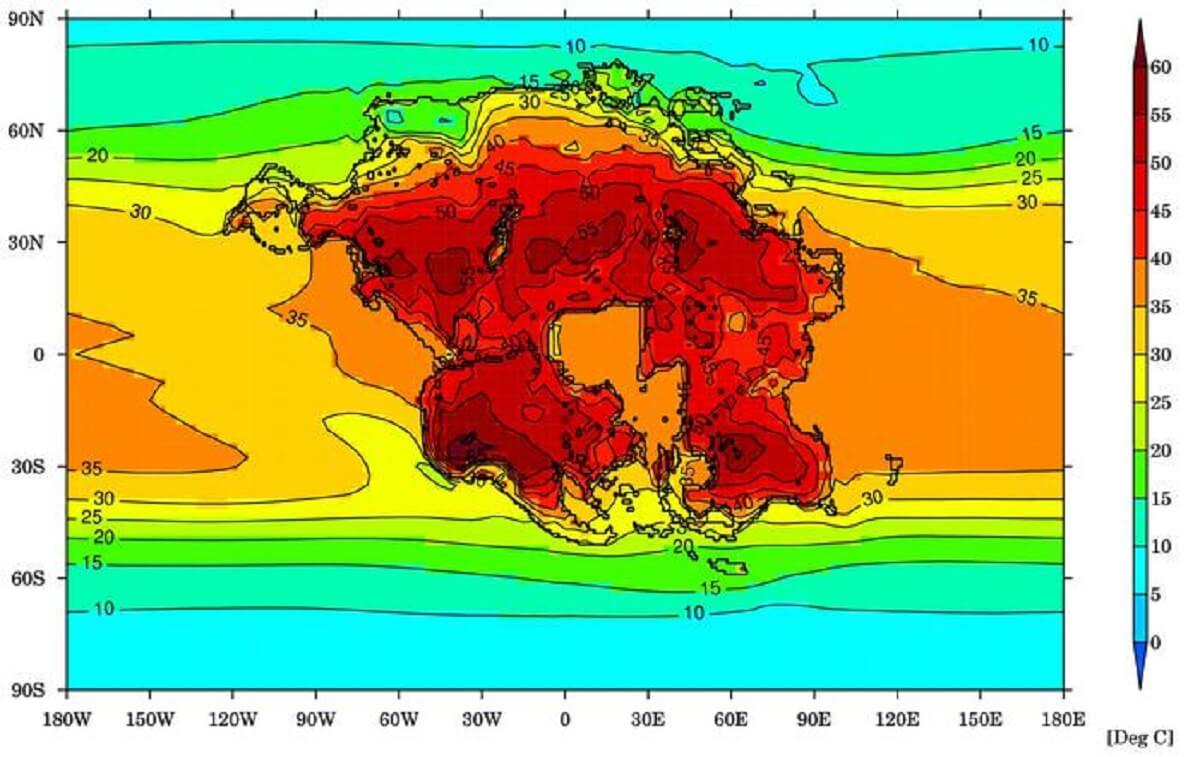BRISTOL, United Kingdom — It’s the end of the world as we know it — but not for a couple hundred million years. According to a new study, extreme heat will likely wipe out all human life and mammals on the planet, in about 250 million years.
Researchers from the University of Bristol suggest that the continents will come together, forming a single, predominantly hot and dry supercontinent. The team has named this mega landmass “Pangea Ultima” and simulated its probable climate, estimating temperatures to vary between 40 and 70 degrees Celsius (nearly 160 degrees Fahrenheit).
Utilizing a supercomputer for climate modeling, they determined that as the Sun gets brighter, Earth’s temperatures will continue to rise. Increased volcanic activity will emit more carbon dioxide, further warming the planet.
A researcher on the team comments that if we persist in burning fossil fuels, the anticipated CO2 levels of Pangea Ultima could become a reality much sooner.
Historically, mammals, including humans, have adapted to varying weather conditions. While they’ve evolved to endure colder climates, their tolerance for extreme heat hasn’t significantly changed. Continuous exposure to extreme heat would be detrimental.
“The newly-emerged supercontinent would effectively create a triple whammy, comprising the continentality effect, hotter sun, and more CO2 in the atmosphere, of increasing heat for much of the planet. The result is a mostly hostile environment devoid of food and water sources for mammals,” says Dr. Alexander Farnsworth from the University of Bristol, in a media release.
“Widespread temperatures of between 40 to 50 degrees Celsius, and even greater daily extremes, compounded by high levels of humidity would ultimately seal our fate. Humans – along with many other species – would expire due to their inability to shed this heat through sweat, cooling their bodies.”

While human-induced climate change is already causing rising temperatures and mortality rates in various regions, the research indicates that significant portions of the planet will remain habitable until this major shift in landmass in the distant future. The team estimates that only eight to 16 percent of the land would be suitable for mammalian life after the formation of the supercontinent.
“While we are predicting an uninhabitable planet in 250 million years, today we are already experiencing extreme heat that is detrimental to human health,” says co-author Dr. Eunice Lo. “This is why it is crucial to reach net-zero emissions as soon as possible.”
The international research group simulated various environmental factors for Pangea Ultima. Through models of tectonic plate movement, ocean chemistry, and biology, they forecasted future CO2 contributions and absorption.
“We think CO2 could rise from around 400 parts per million (ppm) today to more than 600 ppm many millions of years in the future,” adds Professor Benjamin Mills from the University of Leeds. “Of course, this assumes that humans will stop burning fossil fuels, otherwise we will see those numbers much, much sooner.”

The study underscores the significance of tectonics and continental configurations when studying planets beyond our own.
“The outlook in the distant future appears very bleak. Carbon dioxide levels could be double current levels. With the Sun also anticipated to emit about 2.5% more radiation and the supercontinent being located primarily in the hot, humid tropics, much of the planet could be facing temperatures of between 40 to 70 °C,” says Dr. Farnsworth. “This work also highlights that a world within the so-called ‘habitable zone’ of a solar system may not be the most hospitable for humans depending on whether the continents are dispersed, as we have today, or in one large supercontinent.”
The research is published in the journal Nature Geoscience.
You might also be interested in:
- Flower power: Ancestors of modern-day plants survived mass extinction of the dinosaurs
- Sixth mass extinction on Earth already underway, scientists say
- Global warming: Here’s where climate change could lead to record-setting heatwaves soon
South West News Service writer Pol Allingham contributed to this report.


No they don’t. Just like ‘man-made’ climate warming and evolution, as well as carbon dating, it is a hypothesis that cannot be scientifically proven/ repeated. These are ideas that man contrived because they do not want to believe God did any of it; in spite of the overwhelming evidence of the inability for DNA and RNA to create itself.
What a ridiculous article, par for the course for “StudyFinds”, which will publish every piece of trash they can possibly call a “study”. People are dying TODAY from climate change.